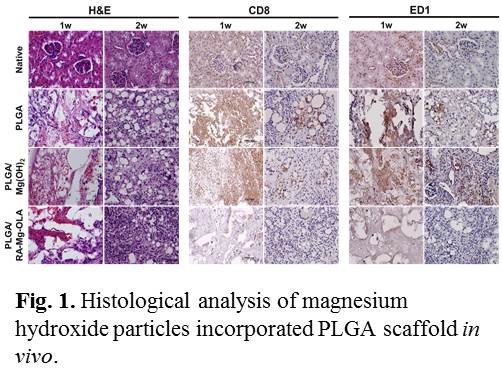Introduction: Chronic kidney disease is now recognized as a major health problem, but current therapies including dialysis and renal replacement have many limitations. Consequently, biodegradable scaffolds to help repairing damaged or injured tissue are emerging as a promising approach in the field of renal regeneration. Poly(lactic-co-glycolic acid) (PLGA) is a useful biomedical material, but acidic degradation products can decrease the physiological pH and cause inflammatory response in the surrounding tissue.
In this stidy, magnesium hydroxide (Mg(OH)2) was adapted to neutralize the acidic environment, and the manufactured Mg(OH)2 incorporated PLGA (PLGA/Mg(OH)2) scaffold was expected to have reduced inflammation and to provide host stem cell recruitment[1]. The physico-mechanical properties of the obtained porous scaffolds were characterized, and the effects of the scaffolds on kidney regeneration were also investigated using a partially defected animal model in vivo[2].
Materials and Methods: The PLGA/Mg(OH)2 scaffolds were prepared by an ice particle leaching method. The structures, morphology, pH change, and thermal and mechanical properties of the porous scaffolds were characterized using various analytic tools. The cell adhesion and proliferation of human renal cortical epithelial cells on the scaffolds were studied. To evaluate in vivo decreases in cytotoxicity and inflammation response through the neutralization effect of the Mg(OH)2, the PLGA/Mg(OH)2 scaffolds were implanted into partial nephrectomized area of mouse. The retrieved renal constructs were conformed using polymerase chain reaction (PCR) and histological and immunohistochemical analyses.
Results and Discussion: Porous PLGA/Mg(OH)2OH scaffolds with different MgOH concentrations were successfully fabricated. The scaffolds have interconnected pore structure with porosity of 80% and pore sizes up to 200 mm. The degradation-dependent pH changes was performed for 28 days at 37 °C. The pH of PLGA control decreased from 6.4 to 2.7, whereas the PLGA/Mg(OH)2 composites were retained at pH 7. The tensile strength and relative yield stress of PLGA/Mg(OH)2 scaffolds were enhanced in the different concentration of Mg(OH)2OH as compared to PLGA only control group. Cell viability increased to around 90% and the expression levels of IL-6 were reduced dramatically with increasing the amount of Mg(OH)2OH from 0 to 20 wt%. Following murine in vivo implantation, the PLGA/Mg(OH)2OH scaffolds showed very low inflammatory response, which means that this scaffold has effective neutralizing ability of acidic environment and supports glomeruli-like structure formation and neovascularity (Fig. 1). As a result, the Mg(OH)2OH particles in PLGA matrix could improveenhace renal reconstriction as well as reduce the inflammatory response.

Conclusions: The Mg(OH)2OH particles were embedded in porous PLGA scaffolds for kidney regeneration. The obtained results demonstrated that incorporated Mg(OH)2OH into the PLGA scaffold could reinforce the mechanical properties, reduce inflammatory response and ultimately enhance renal reconstriction. The PLGA/Mg(OH)2OH scaffolds could be one of the promising materials for biomedical applications including tissue engineered scaffolds, biodegradable implants, and stents.
References:
[1] C.H. Kum, Y. Cho, S.H. Seo, Y.K. Joung, D.J. Ahn, and D.K. Han, Small, 2014, 10, 3783.
[2] S.H. Choi, S.Y. Chun, S.Y. Chae, J.R. Kim, S.H. Oh, S.K. Chung, J.H. Lee, P.H. Song, G. Choi, T. Kim, and T.G. Kwon, J. Biomed. Mater. Res. A, 2014, 103, 1391.